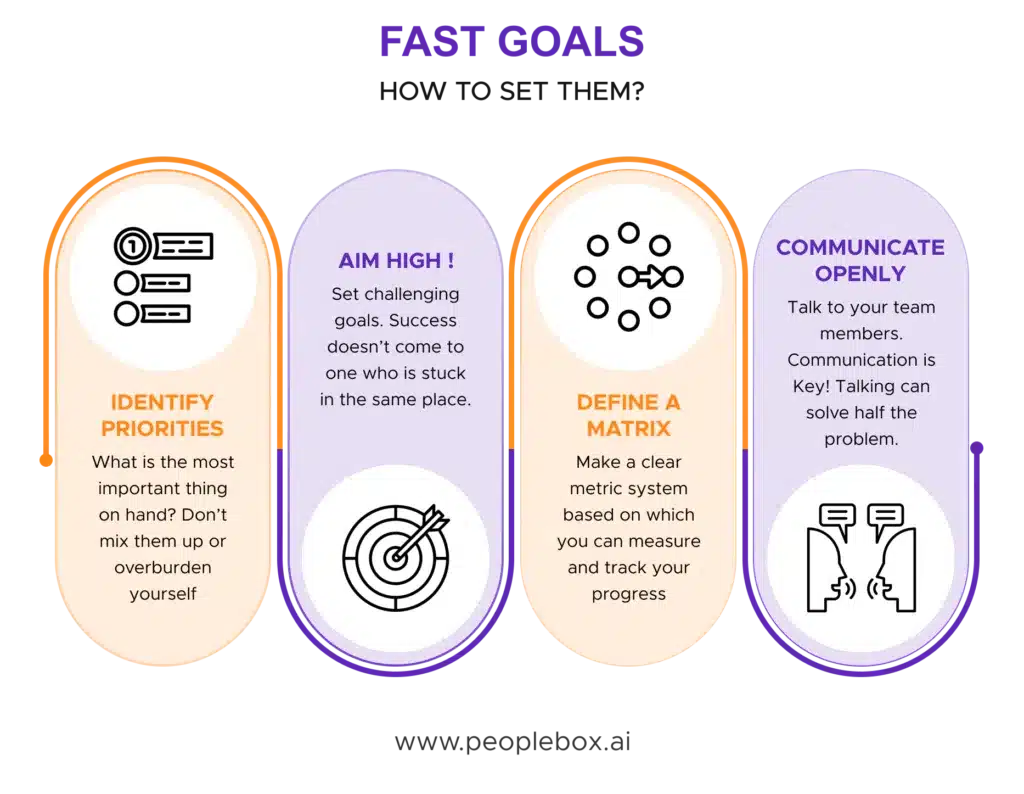When Peter Ducker introduced the idea of FAST goals, he never imagined it would be the reason for the success of hundreds of businesses.
Setting goals provides us with direction and a sense of purpose. Most managers follow a standard approach during goal setting: hold meetings, review performances, and give predefined goals to workers.
But they seldom ask- does it work? Now imagine crafting frequently discussed goals to motivate the employee, specific to their strengths and weaknesses and realistic!
That is the idea of a FAST goal.
What are Fast Goals?
FAST stands for Frequently Discussed, Ambitious, Specific and Transparent.
FAST goals help organizations improve on many dimensions all at once. Building on the SMART method, this technique further improves the quality of setting goals. FAST and SMART goals can be complementary, offering both flexibility and clear, measurable objectives. FAST stands for:
Frequently discussed
In large multinational corporations, goal setting is a New Year ritual often neglected in the later days.
However, the FAST aim fosters continual debate of the goals and developing a plan to attain them.
It asks for frequent goal reviews and setting goals for shorter periods, such as quarterly.
This keeps them more relevant to the current work. LinkedIn’s CEO Jeff Weiner meets with his senior team every week for approximately three hours.
They debate tactical plans, performance reviews, and evaluate the company’s success on a micro and macro scale.
Ambitious
It is enticing to set soft and easily achievable goals.
FAST goals push thinking beyond the comfort zone. They encourage employees to set ambitious and challenging goals that align with the organization’s long-term vision, ensuring sustained success.
It encourages employees to set ambitious and challenging goals, push them to aim high, and stay motivated to achieve more. This can also help move the organization towards its own set of goals.
Setting ambitious goals can also prevent employees from sandbagging by setting very conservative goals that they are sure to achieve.
When Nike announced its ‘Move to Zero’ Campaign, the company made it a goal to switch to 100% renewable energy by 2025. By 2021, Nike completely eradicated single-use plastic bags in all its stores. Rustique-Petteni says it’s ‘one of the most ambitious goals Nike has ever undertaken’. Such goals have a serious impact on the quality of life, that too driven by a sports brand.
Specific
In the 1970s, Intel decided to switch from memory chips to microprocessors. Andy Grove, the then CEO of Intel identified that the OKR metric system suited their strategy perfectly.
It became so popular later that the method became widely used in the silicon valley.
FAST goal methodology emphasizes that goals are ‘specific’ and can be translated into a tangible metric system. It can help the employee or the manager to track progress. Most employees set generic goals, like ‘I want to achieve X this year’. Such goals are just wishes and do not help them achieve anything. A quantifiable goal ensures real progress tracking and improves the performance of the employee. Additionally, it also helps the team leader know what to expect from the team and measure success effectively.
Transparent
How many people in the same team are aware of each others’ goals? FAST goals state that everybody’s goals need to be easily accessible, from the top to bottom of the organization.
It holds people accountable for their actions and also asks for help whenever needed.
Google is a standing testimony to the success of transparency in goals. It posts all the employee’s past and present goals next to their contact information in the employee internal directory.
Set, Align & Track OKRs
Get a glimpse of Peoplebox simplifies goal setting, tracking, and alignment.
Checklist to Choose The Right OKR Software
How to write FAST goals and track progress?
Building FAST goals is not necessarily a difficult task. There are a few things you need to focus on while defining your FAST goals. These steps will help ensure successful strategy execution.

Identify the priorities- Determine what is most crucial! Adding too many goals may lead to diluting your efforts.
Aim for bold goals- Push yourself every day! It only makes you a better version of yourself. Ensure it challenges your current limit and drives significant progress. Make sure your goals are achievable (not unrealistic).
Define a clear matrix- Keep track of your progress. Set performance reviews regularly and fix a clear scale against which your progress can be tracked. It will help you understand how close you are to achieving your goal.
Communicate openly- Talk to your manager. Let them know how you are doing in your goal setting. Ask for help if you need it. Be open about issues and have a positive and solution-oriented attitude.
Set, Align & Track OKRs
Get a glimpse of Peoplebox simplifies goal setting, tracking, and alignment.
Checklist to Choose The Right OKR Software
Benefits and Challenges of FAST Goals: How to Measure Success
Like every other goal-setting method, the FAST methodology also has its own set of advantages and challenges:
| Benefits | Challenges |
| 1. FAST goals specify various focus areas. It gives specific goals which are easy to troubleshoot or improve. | 1. This approach might not be suited for all situations. There is a possible chance of over-stretching the employees leading to burnout. |
| 2. They push the employees to become high achievers, resulting in progress | 2. Oversharing may lead to burdening on managers |
| 3. Specific metric systems can help measure progress precisely. | 3. Over-specifications may lead to overlooking some important goals. |
| 4. Transparent goal setting ensures better allocation of company resources. | 4. Risk of short-term focus, neglected long-term goals. |
How are FAST goals different?
What is the difference between the FAST goal method and the other methods involved in goal setting? Many older methods like SMART goal and OKR have been significant players in the field. However, traditional goal setting methods often lack the agility and transparency that FAST goals provide.
FAST vs SMART Goals: Understanding the Differences
SMART refers to specific, measurable, achievable, and realistic. It mainly focuses on individual performance and goals while FAST goals talk about continuous discussion of the goals of the company.
SMART goals are usually long-term, steadily progressing toward the endpoint. FAST goals on the other hand prioritize speed, enabling quick adjustments and response to rapid change in the environment. Combining smart and fast goals can provide a balanced approach to goal setting.
FAST Goals encourage team members to align, ensuring that all goals contribute to the team and organization’s overall success. Furthermore, frequent talks enable everyone to reallocate resources or reassess milestones and deadlines, increasing the likelihood of everyone fulfilling goals.
FAST goal approach is more flexible, promotes agility, and is adaptable making it a popular choice
FAST vs OKR
OKR is the acronym for Objective and Key results. Objectives refer to the goals and the Key results are the measurable milestones that determine the progress towards the achievement. It is known to foster alignment and transparency, which are crucial for successful strategy execution. It can also involve cascading a set of goals throughout the organization. FAST goals focus more on structured and individualized approaches.
OKR does not specifically emphasize frequent discussions, unlike the FAST Goals.
OKRs can be implemented along with a FAST goal approach to structure a better framework for goal setting.
While the FAST goal scheme provides ambitious and relevant goals, OKR can be used to critically measure the progress of goals. The strategy is typically given as a holistic framework for goal and performance management, and it is implemented through the establishment of effective OKR processes.
The so-called OKR cycle is the foundation of a successful agile goal and performance management system, allowing you to better implement, achieve, and monitor your FAST goals.
20+ Examples of Fast Goals
Here are some real-world fast goals examples that show FAST goals in action!
Example 1:
Company: Salesforce
Goal Example: Increase revenue $34.9 billion by FY2024.
Example 2:
Company: Amazon
Goal Example: Increase the number of prime memberships to over 200 million worldwide by 2021.
Example 3:
Company: Apple
Goal Example: Achieve a quarterly revenue target of $85.8 billion, 5 % over year.
Example 4:
Company: Netflix
Goal Example: 230 million global subscribers by the end of 2021
Example 5:
Company: Microsoft
Goal Example: Achieve $50 billion in annual cloud revenue by FY2021
Example 6:
Company: Tesla
Goal Example: Deliver 5 million vehicles in the year 2020
Example 7:
Company: Adobe
Goal Example: Increase its Grow digital experience revenue to $11.2 billion by FY2021
Example 8:
Company: Spotify
Goal Example: Reach a total of 400 active users with 180 million premium subscribers by 2021
Example 9:
Company: Oracle
Goal Example: Achieve $40 billion in cloud revenue by 2022.
Example 10:
Company: IBM
Goal Example: Obtain $12 million revenue from its cloud and cognitive software by 2021
Example 11:
Company: Intel
Goal Example: Achieve $10 billion in revenue from data center sales by 2021.
Example 12:
Company: SAP
Goal Example: Achieve €12 billion in cloud revenue by 2023.
Example 13:
Company: Cisco
Goal example: Generate $5 billion in revenue from security solutions by 2022.
Example 14:
Company: Uber
Goal Example: Reach 135 million monthly active users by Q4 2021.
Example 15:
Company: Qualcomm
Goal Example: Achieve $20 billion in revenue from mobile handsets by 2022.
Example 16:
Company: Snap Inc.
Goal Example: Reach 400 million daily active users by the end of 2021.
Example 17:
Company: Peloton
Goal Example: Reach 4.4 million subscribers by 2022.
Example 18:
Company: Shopify
Goal Example: Achieve $120 billion in Gross Merchandise Volume (GMV) by 2022.
Example 19:
Company: Hulu
Goal Example: Reach 45 million total subscribers by 2022.
Example 20:
Company: Zoom
Goal Example: Reach 500 million daily meeting participants by the end of 2020.
These examples show how varied organizations from many industries have set and achieved ambitious goals utilizing the FAST framework, resulting in major improvements and market influence.
Use Peoplebox for Goal Management
Peoplebox provides a single source of truth for all of your company, team, and individual goals and keeps them updated in real-time with 50+ native integrations.
It supports multiple types of goal methodology to help your team align on business goals. Further, It lets you create custom business review dashboards with auto-populated OKRs to run business review meetings. The SMART framework is one of the many methodologies that Peoplebox can integrate with to enhance goal management.
What makes Peoplebox stand out?
Unified Goal Management: Peoplebox ensures that everyone in your organization is working toward the same vision. With real-time updates and visibility across teams, it streamlines goal execution and boosts productivity. Whether it’s OKRs, KPIs, or any other framework, Peoplebox adapts to your unique needs.
Deep Integrations: With over 50 native integrations, including Jira, Asana, and Slack, Peoplebox automatically tracks progress, reduces admin workload by 90%, and allows your team to focus on what really matters—achieving goals.
Performance Management: Our platform offers customizable performance reviews, enabling continuous feedback and real-time insights. Integrated with Slack and Microsoft Teams, Peoplebox makes performance management effortless.
Employee Engagement: Beyond goal tracking, Peoplebox enhances employee engagement with powerful analytics, 360-degree feedback, and automated surveys, fostering a high-performing and satisfied workforce.
Trusted by over 500 organizations across 60+ countries, Peoplebox is more than just a tool—it’s your partner in driving strategic success. Ready to take your organization to the next level? Request a demo today and see how Peoplebox can help you achieve bigger goals.







